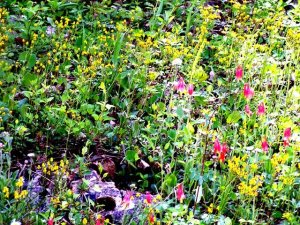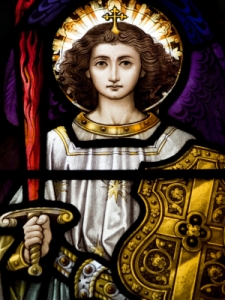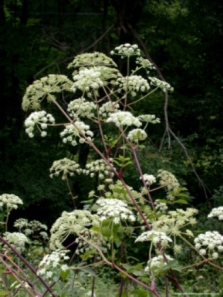 As a child growing up during the 19th century, or so it sometimes seems, I remember placing baskets of flowers as a surprise on friend’s doorstep early on a lovely May Day morn. Also, dancing around the May Poll festivities in which, not I, but my younger brother and sister both participated. The little girls with garlands in their hair, decked out in pretty spring dresses. Mom made my sister’s. One year the wind toppled the May Poll and then there’s the time the children got all wound up in the ribbons and over it went. Humiliating for my young brother who’d practiced so hard and tried to no avail to instruct his fellow dancers to wind them properly. I never did trust that May Poll thing to go as planned and hoped to be crowned May Queen, surrounded by a glad assembly of courtiers. No such luck. But May Day was special and has strong flowery associations in my memory. And wind. It never entered anyone’s mind that this revelry had possible pagan connotations. May Day festivities were simply a spring rite and good fun. (*Image of cherry tree in our yard)
As a child growing up during the 19th century, or so it sometimes seems, I remember placing baskets of flowers as a surprise on friend’s doorstep early on a lovely May Day morn. Also, dancing around the May Poll festivities in which, not I, but my younger brother and sister both participated. The little girls with garlands in their hair, decked out in pretty spring dresses. Mom made my sister’s. One year the wind toppled the May Poll and then there’s the time the children got all wound up in the ribbons and over it went. Humiliating for my young brother who’d practiced so hard and tried to no avail to instruct his fellow dancers to wind them properly. I never did trust that May Poll thing to go as planned and hoped to be crowned May Queen, surrounded by a glad assembly of courtiers. No such luck. But May Day was special and has strong flowery associations in my memory. And wind. It never entered anyone’s mind that this revelry had possible pagan connotations. May Day festivities were simply a spring rite and good fun. (*Image of cherry tree in our yard)
How about the rest of you? Any May Queens among us?
More on May Day from: http://www.infoplease.com/spot/mayday.html
 “May 1st, often called May Day, just might have more holidays than any other day of the year. It’s a celebration of Spring. It’s a day of political protests. It’s a neopagan festival, a saint’s feast day, and a day for organized labor. In many countries, it is a national holiday. (Royalty free image of birch tree)
“May 1st, often called May Day, just might have more holidays than any other day of the year. It’s a celebration of Spring. It’s a day of political protests. It’s a neopagan festival, a saint’s feast day, and a day for organized labor. In many countries, it is a national holiday. (Royalty free image of birch tree)
Beltane
A Celtic calendar feast ushering in the start of summer. (It also went by a variety of other spellings and names in assorted dialects of Gaelic.)
Bonfires, often created by rubbing sticks together, were common features of Beltane celebrations. Related rituals included driving cattle between two fires, dancing around the fires, and burning witches in effigy. Another tradition was Beltane cakes, which would be broken into several pieces, one of which was blackened. They would be drawn by celebrants at random; the person getting the unlucky blackened piece would face a mock execution.
In recent years, Beltaine has been adopted or revived by neopagan groups as a major seasonal festival.
Bringing in the May: *This is more what I remember. :)
In medieval England, people celebrated the start of spring by going out to the country or woods “going a-maying” and gathering greenery and flowers, or “bringing in the may.” This was described in “The Court of Love” (often attributed to Chaucer, but not actually written by him) in 1561. Totally irrelevant, but I am a direct descendent of Chaucer on my father’s side.
 “And furth goth all the Court, both most and lest,
“And furth goth all the Court, both most and lest,To feche the floures fressh, and braunche and blome;
And namly, hawthorn brought both page and grome.
With fressh garlandes, partie blewe and whyte,
And thaim rejoysen in their greet delyt.”
(*Wild roadside flowers near us)
Another English tradition is the maypole. Some towns had permanent maypoles that would stay up all year; others put up a new one each May. In any event, the pole would be hung with greenery and ribbons, brightly painted, and otherwise decorated, and served as a central point for the festivities.
May Day was also a time for morris dancing and other dances, often around the maypole. In the 19th century, people began to braid the maypole with ribbons by weaving in and out in the course of a dance. Other later traditions include making garlands for children and the crowning of the May Queen.”
From an interesting site: Herbal Musings
“Beltain, Bealtaine, Beltine, May Day, Cetsamhain (‘first Samhain‘), Walpurgis Night (Beltane Eve), Celtic ‘Flower Festival’
Druidic Name: Beltane
 Christian Equivalent
Christian Equivalent
Roodmas, Rood Day, Feast of Saint Philip and Saint James, Feast of Saint Walpurga
Beltane is the cross-quarter festival that marks the start of the summer quarter of the year and the end of the spring quarter. This is a time when nature blossoms and felicity and fertility return to the land. In times past, the livestock stockaded at Samhain was returned to summer pastures at Beltane.
…a joyful festival of growth and fecundity that heralds the arrival of summer. It is the festival of the ‘Good Fire’ or ‘Bel-fire’, named after the solar deity Bel. Bel was also known as Beli or Bile in Ireland, with Bile meaning ‘tree’, so Beltane may also mean ‘Tree-fire’. Beltane is the counterpart of Samhain (and is sometimes referred to as Cetsamhain, the ‘first Samhain’), and these two important festivals divide the year into summer and winter halves, just as the two equinoctial celebrations, Ostara and Mabon, divide the year into light and dark halves.
Lighting fires was customary at Beltane, and traditionally a Beltane fire was composed of the nine sacred woods of the Celts. All hearth fires were extinguished on Beltane Eve and then kindled again from the sacred “need fires” lit on Beltane. People would leap through the smoke and flames of Beltane fires and cattle were driven through them for purification, fertility, prosperity and protection.
 It is a traditional time for Handfastings (marriages), and for couples to make love outside to bless the crops and the earth. Maypoles were often danced around at Beltane to bring fertility and good fortune. Beltane lore also includes washing in May-day dew for beauty and health, and scrying (peeping) in sacred waters, such as ponds or springs.
It is a traditional time for Handfastings (marriages), and for couples to make love outside to bless the crops and the earth. Maypoles were often danced around at Beltane to bring fertility and good fortune. Beltane lore also includes washing in May-day dew for beauty and health, and scrying (peeping) in sacred waters, such as ponds or springs.
The festival is sometimes referred to as Roodmas, a name coined by the medieval Christian Church in an attempt to associate Beltane with the Cross (the Rood) rather than the life-giving symbol of the Maypole. Beltane was also appropriated by the Church as the Feast Day of Saint Walpurga, who was said to protect crops and was often represented with corn.”
(*Royalty free images of the Archangel Michael and the sacred herb Angelica)

No comments:
Post a Comment